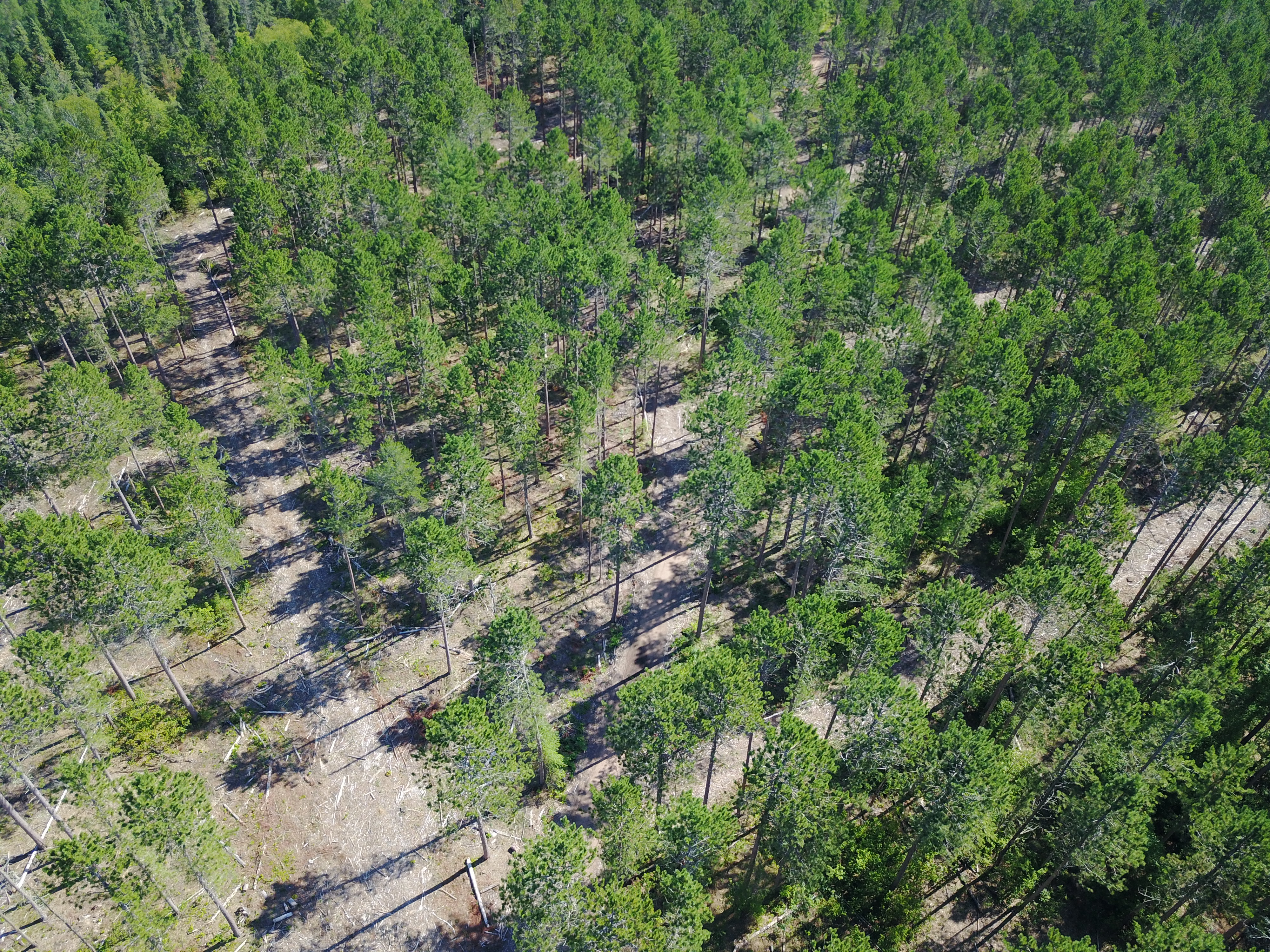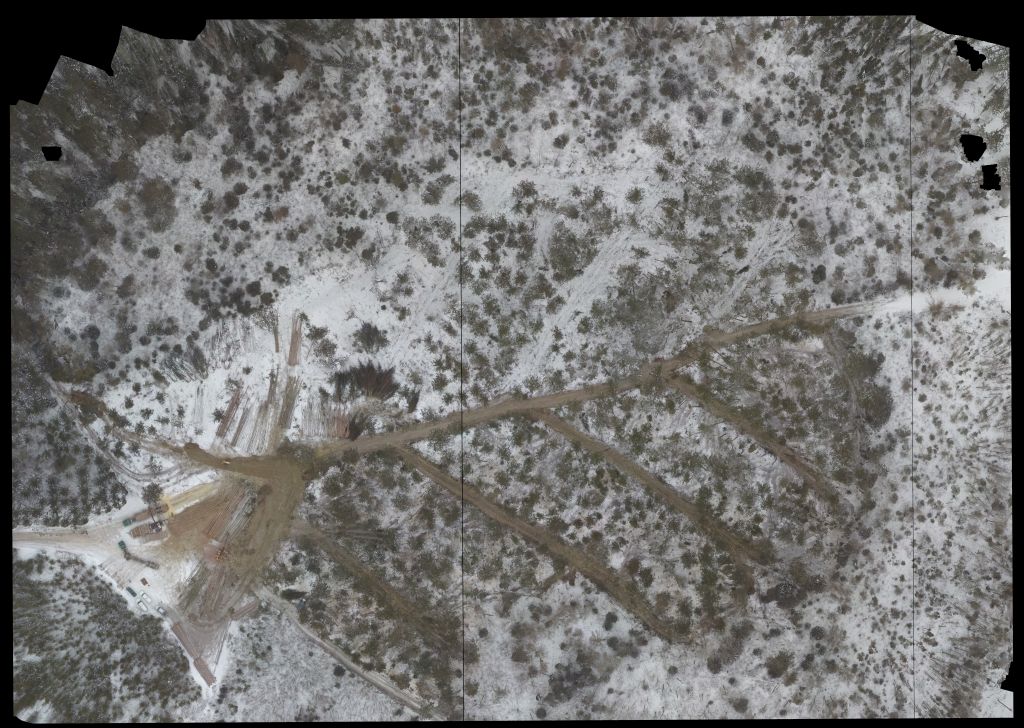Overview
This is an experimental prescription designed to naturally regenerate red pine under red pine in the face of various economic and ecological constraints. The primary economic constraints consist of 1) the risk of losing high value trees to disturbance, such as windthrow, when retained to serve as seed trees and 2) the time available by a forester to plan and execute a non-coppice natural regeneration silvicultural system. The primary ecological constraint, in Minnesota at the time of writing (2017), is 1) pathogenic in the form of Diplodia pinea (Desm.) and/or Sirococcus strobilinus (Preuss). In some instances, the first economic constraint has caused foresters to retain lower value seed trees during the seed-tree cut. While this should not cause too much concern for the future genetics of a red pine stand it can limit the forester’s ability to conduct a profitable overwood removal sale once adequate regeneration has been secured, sometimes causing the overwood to remain indefinitely. Indefinite overwood retention causes a complete loss of the economic value of retained trees and can also cause regeneration loss, sometimes 100%, due to pathogen infection. The pathogenic threat of Diplodia and Sirococcus, both of which reside in the canopy of red pines and are moved via spores picked up by rain splashes, has caused great fear in foresters to attempt natural regeneration in red pine, regardless of the potential economic constraints.
The second economic constraint, the time of the forester, is not an idle constraint to consider. At a minimum for a successful seed tree silvicultural system with passive scarification, the forester will need to visit the stand eight times during two entries:
1 - Seed tree entry: cruise, mark boundaries/roads/removals, timber sale administration (TSA), and regeneration check
2 - Overwood removal entry: cruise, mark boundaries (roads and removals should be obvious), TSA, and regeneration check.
In essence, this is nearly the time-equivalent of two sales for one stand; although, an artificial regeneration silvicultural system requires at least five visits (cruise, mark, TSA, plant, and regeneration check).
Given these constraints, why would a forester ever consider natural regeneration in red pine? The answer: diversity at both landscape and, potentially, stand scales. As foresters we know that we should never be prescribing the same practice over the entire landscape because not all systems behave in the same way and also because it could create the opportunity for ecological and/or economic collapse if our forest resources assets are not diversified. To ward off such threats, we vary our silvicultural practices around the landscape to promote both intra- and inter-stand diversity. In this vein, we should be varying our silvicultural systems for red pine and not solely rely on artificial regeneration. This will diversify red pine forest resource for both known and unknown constraints and future scenarios.
This trial hopes to overcome these contraints by retaining a sufficient volume of high-value trees until the final entry, in a systematic spacial structure that minimizes loss of regeneration to pathogens and makes for efficient operation, allowing all three stand entries to be profitable.
Silviculture Objective(s)
To conduct three profitable entries into a mature, even-aged red pine stand in order to naturally regenerate even-aged red pine to a high stocking level (at least 600 trees per acre) for, primarily, future timber production.
Pre-treatment stand description and condition
Stand establishment and management history:
Stand was established following initial cutover of area in 1909. Residual trees from ~1800 seem to have been left in the stand, possibly as seed trees. Three previous harvests have occurred on this stand:
1942- Thinning of some old growth red pine, approx. 110.4 cords removed over 9.5 acres, including part of this stand
1947- Removal of additional old growth pine, totaling 36.14 cords, over 7.8 acres including parts of this stand
1990- Thinning of an unknown volume over 9.8 acres including parts of this stand
Pre-treatment species composition:
Of ~191 ft^2/ac basal area, 165 ft^2 acre (86%) was red pine, and the remainder a mix eastern white pine, white spruce, aspen, and jack pine.
Pre-treatment growth and stocking:
|
DBH class midpoint (in) |
ABBA |
BEPA |
PIBA |
Picea |
PIRE |
PIST |
Populus |
TOTAL Vol |
Proposed Harvest Vol |
Proposed Retention Vol |
|
6 |
0.0 |
0.0 |
0.0 |
0.0 |
8.3 |
1.6 |
0.0 |
9.9 |
9.9 |
0.0 |
|
8 |
3.1 |
1.6 |
0.0 |
4.2 |
55.9 |
0.0 |
2.8 |
67.6 |
62.0 |
5.6 |
|
10 |
2.3 |
3.3 |
7.6 |
5.3 |
130.1 |
2.7 |
3.3 |
154.5 |
63.5 |
91.1 |
|
12 |
0.0 |
2.8 |
0.0 |
0.0 |
182.6 |
2.8 |
10.9 |
199.0 |
43.8 |
155.2 |
|
14 |
0.0 |
0.0 |
7.7 |
3.1 |
132.4 |
0.0 |
7.3 |
150.5 |
38.0 |
112.5 |
|
16 |
0.0 |
0.0 |
0.0 |
3.8 |
87.2 |
0.0 |
0.0 |
91.0 |
21.2 |
69.8 |
|
18 |
0.0 |
0.0 |
0.0 |
0.0 |
46.2 |
3.8 |
0.0 |
50.0 |
15.3 |
34.7 |
|
20 |
0.0 |
0.0 |
0.0 |
0.0 |
37.1 |
0.0 |
0.0 |
37.1 |
11.1 |
26.0 |
|
22 |
0.0 |
0.0 |
0.0 |
7.7 |
0.0 |
0.0 |
0.0 |
7.7 |
7.7 |
0.0 |
|
Total |
5.4 |
7.6 |
15.4 |
24.2 |
679.9 |
10.8 |
24.2 |
767.5 |
272.7 |
494.8 |
Pre-treatment forest health issues:
Sirococcus and Diplodia blights observed in nearby stands, porcupine damage observed nearby. Armillaria root rot spores known to reside in soils of nearby stands
Landowner objectives/situation:
The Cloquet Forestry Center objectives are to conduct applied education, research, and outreach. This trial is expected to test the bounds of red pine production management and encourage creative, yet reasonable, solutions to current and future management constraints.

Figure 1: Pre-harvest stand conditions

Figure 2: Pre-harvest stand conditions
Silviculture Prescription
For the first entry, which will occur in the winter, parallel clearcut strips 15 ft wide and 150 ft apart, obtusely angled towards final skidding destination (to amke corners as easy as possible for large trees) will be established as skid rows. The retention strips will be thinned from 191 ft^2/acre to 115 ft^2/acre, removing ~273 cords and retaining ~495 cords, as 115 ft^2/acre is thought to expose retention trees to moderate amounts of wind and sufficient light to both respond to the thinning and increase their structural strength to prevent windthrow.
The second entry, to occur during the growing season, will widen the established skid rows to a point sufficient for red pine regeneration, which will be determined based on stand volume at the time of harvest. An estimate of at least 200 cords will be removed to ensure profitability.Skid rows will now become regeneration strips through passive scarification from full-tree skidding. A minimum of 21 cords per acre (~200 cords total) will be retained across the stand in the seed tree retention strips to ensure the potential profitability of the final entry.
The final entry will remove all overwood seed trees left in the retention strips, once natural regeneration stocking targets are met (>600 trees per acre). The retention strips will serve as skid rows to minimize disturbance to regeneration. Artificial regeneration may be necessary in these strips to promote even stocking.
What actually happened during the treatment
Pre-sale, the centers of the skid roads were flagged, then all trees within 7 ft of the center were marked for removal. In the remaining reserve strips, trees were marked to meet the prescribed basal area. The marking protocol, although time consuming, was designed to ensure the harvest would be easy for the operator to conduct.
The stumpage for the first entry was purchased by Bell Timber, Inc. and the harvest was operated by Berthiaume Logging, Inc. between December 5-16, 2016. Approximately 9.7 acres of the stand received the prescribed treatment , while the remaining 2 acres were clearcut with minimal reserve seed trees and used as a processing area and landing. The full-tree conventional harvesting operation was conducted with a feller-buncher, grapple skidder, delimber, and slasher. Tops and under-sized or non-merchantable material was either chipped or dispersed throughout the operations area.
Post-treatment assessment
Remaining basal area:-115 (>98% red pine) with a standard error of 8.93 ft^2/ac (n=30)
Live crown ratio- 40% with a standard error of 2% (n=35)
420.6 cords with a standard error of 7.4% or 31.3 cords
Less than the prescribed 495 cords was retained, but sufficient volume still remains for two entries of 200 cords. The live crown ratio should be sufficient for this stand to respond well to release, although we expect to see mostly foliar response for the first 5-10 years.
In the 2 acre clearcut area, two replicates of a white pine herbivory experiment were installed (seedlings planted) in June 2017, these plots will be fenced by fall of 2017 according to experimental specifications. The experiment seeks to assess the practicality and effectiveness of using 5 ft. tall perimeter fencing at 50' and 100' lengths to prevent deer browse.

Figure 3: Post sale stand conditions

Figure 4: Post sale stand condition
Plans for future treatments
The second entry is planned for between 2024 and 2027, although if sufficient growth has not been observed by that point to improve the structural integrity of the stand, it may be delayed.
The third and final entry is scheduled to occur approximately 5 years after the second, pending observation of sufficient regeneration.
After the third entry, artificial regeneration may be implemented in the harvested strips to ensure even stocking.

Figure 5: Aerial view of sale area facing East

Figure 6: Photo mosaic of sale area, Dec. 12, 2016
Costs and economic considerations
One of the main purposes of this experiemental treatment is to ensure all entries related to the regeneration regime are profitable- the initial entry was fairly simple to design and mark, requiring little additional time from the forestry staff. Later entries are likewise designed to be simple extentions of the original layout. If sufficient volume remains after the second entry (we plan on removing ~200 cds. in each of the two upcoming entries), the entire presciption should yield a profit for each step.
A consideration for future entries is the timing of removal of the most valuable trees; if these trees are left until the final entry, the risk of loss is significantly increased. For this reason, the second entry may be re-designed to remove the most valuable individuals while retaining greater volume, to ensure a profitable third entry while minimizing risk. Stand conditions at the time of this entry (8-10 years from 2016) will ultimately determine this decision.
Summary / lessons learned / additional thoughts
At this point, it is too early to draw any conclusion from this experimental treatment. After the second entry, monitoring the success of regeneration will be critcial to assessing the viability of a treatment along these lines.
Supplemental content
Submitted by
Kyle Gill
Kyle has been the CFC forest manager and research coordinator since 2015. He enjoys exploring stand development, silviculture, and the inherent biases that we bring to decision making. He feels it is important to see himself and other humans as community members of forested and non-forested ecological communities.
